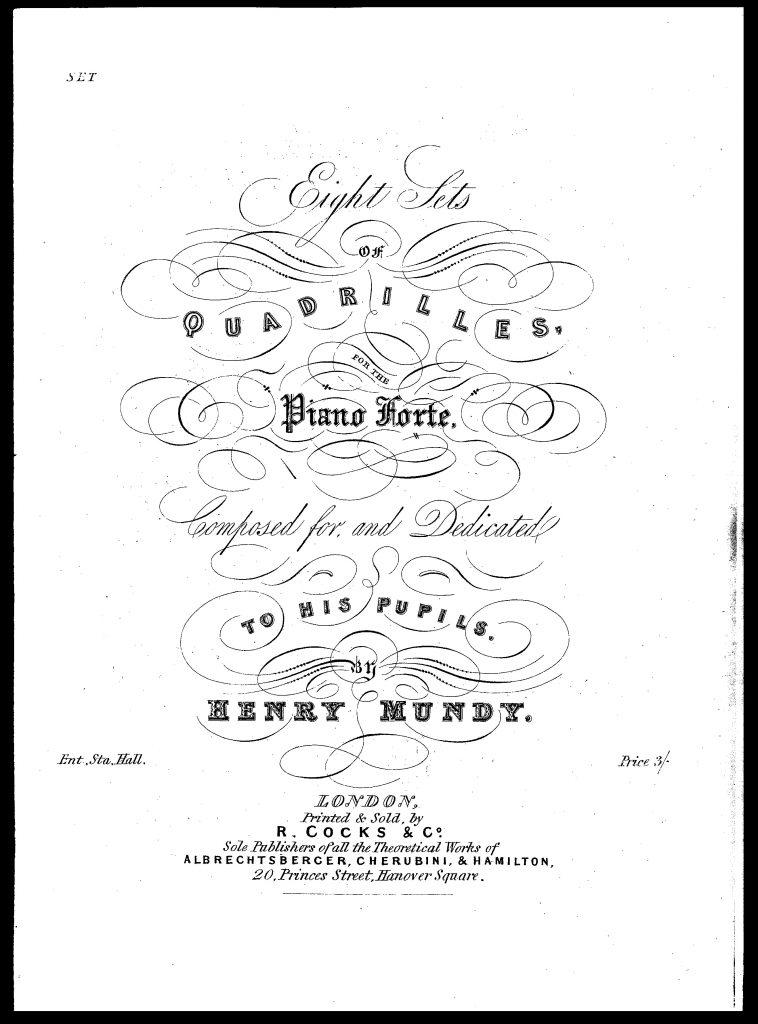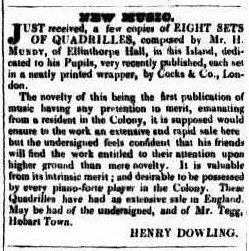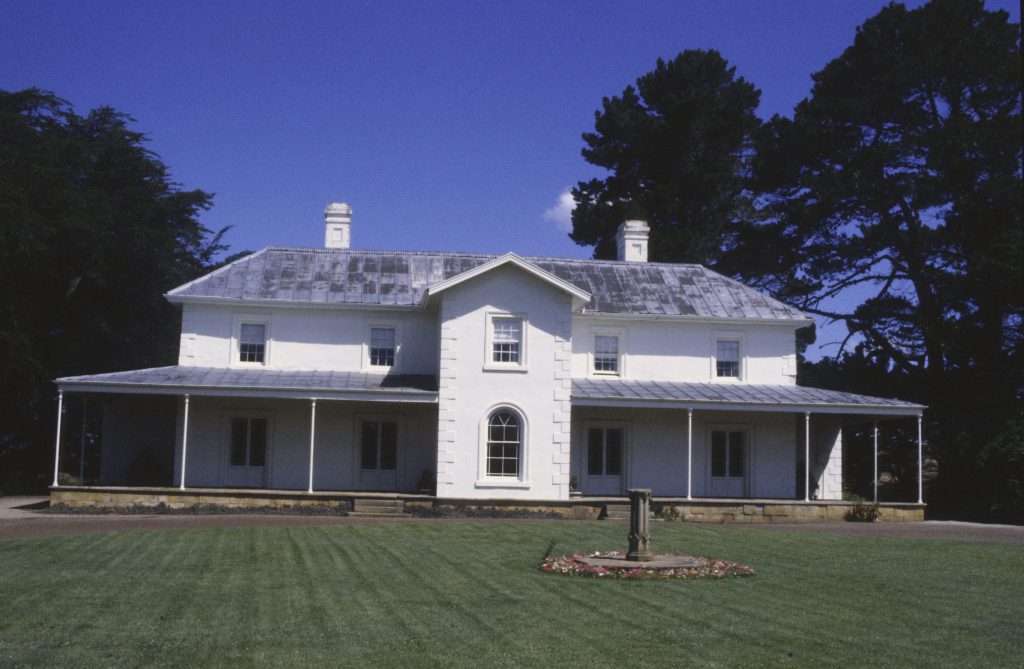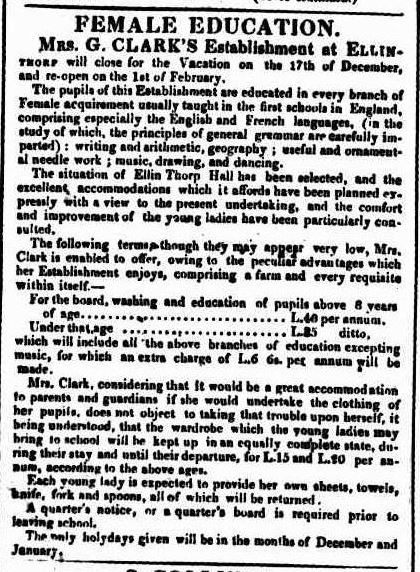… this is the largest and most significant body of settler musical work to survive from Australia before the 1840s. The quadrilles are … competently crafted, melodically original and textually varied. Most of them are tonally and chromatically rather more inventive and sophisticated than many other Australian examples… 1
In 1838, Henry Mundy’s quadrille music was published in London. He composed and dedicated Eight Sets of Quadrilles to his students at the exclusive boarding school, Ellenthorpe Hall, in the Midlands of Van Diemen’s Land.
Mundy was a talented young artist, who had trained at the Royal Academy and toured on the continent. At the age of 33, he was enticed to travel from London to take up the position of drawing master, and teacher of music and French at Ellenthorpe Hall, the fashionable college for young ladies.
Ellenthorpe Hall was opened in September 1827 by Mrs Hannah Clark and quickly gained the reputation of being a highly regarded establishment, which attracted the cream of Tasmanian society, including Eliza Collins, the daughter of Tasmania’s first governor, David Collins. The two storey, sandstone house had been built using convict labour the previous year. Still standing nearby are the barracks which housed their guards. Hannah’s husband, George Clark named his new home for the mansion where he was born in 1797, Ellenthorpe Hall in North Yorkshire. George had emigrated to Hobart in 1822 and was joined by his fiancée, Hannah Maria Davice, the following year. Hannah had arrived with the intent of establishing an elite school and proposed to offer tuition …
in every branch of Female acquirement usually taught in the first schools in England, comprising especially the English and French languages, … writing and arithmetic, geography; useful and ornamental needle work ; music, drawing, and dancing.4
The fees were intended for a wealthy clientele with an annual charge of £40 to cover “board, washing and education” and an additional cost of £6/6s for music lessons. Each young lady was expected to provide her own sheets, towels, knife, fork and spoons. A visitor to the school in 1833 wrote that it was “an excellent establishment which has, no doubt, contributed its share in giving to the upper class of Tasmania the refinement for which it is distinguished.”6 In addition, Mrs Clark educated several motherless children and orphans at “a very reduced expense, or altogether gratuitously”7, though it appears that students were only accepted if they were sufficiently well-bred.
One of the first teachers at the school was the highly esteemed Joseph Riechenberg, the former band master of the 40th Regiment. He had already composed the music for the Australian Quadrilles (1825), and the Hobart Town Quadrilles (1828), and later wrote New Quadrilles and Country Dances for 1832.8 The Hobart Town Courier reported that Riechenberg’s departure to take up the role of music master at Ellenthorpe Hall would be “severely felt by the families in Hobart town where he has been teaching so long with such success.”9 However, Riechenberg only remained as the resident music master at the school from January 1829 to December 1830, when he returned to Hobart.
Henry Mundy succeeded Riechenberg in 1831 and in due course began composing his own quadrille music. Whereas Riechenberg only offered his music to the local market, Mundy’s music was printed in England, where, according to the Hobart music seller, Henry Dowling, it generated extensive sales.10 Mundy’s Eight Sets of Quadrilles was described as being, not only a novelty, but also “valuable from its intrinsic merit; and desirable to be possessed by every piano-forte player in the Colony”.10 The music is arranged with five distinct tunes in each set, corresponding to the figures of the dance. Instructions for these dances will be posted to the website shortly.
It is interesting to note that the music was composed on a piano belonging to Lady Jane Franklin. The piano is now on display at Narryna Heritage Museum, Battery Point, Hobart. Lady Jane was the wife of Sir John Franklin, Lieutenant-Governor of Van Diemen’s Land, who later gained fame as an Arctic explorer.

During the vacations, when no students were resident at Ellenthorpe Hall, Mundy offered music lessons in Launceston.11
In the economic downturn of late 1830s, the school at Ellenthorpe Hall was closed and the market for Mundy’s artistic talents declined.12 The unfavourable financial situation continued into the 1840s causing Mundy to suffer from severe depression. Unhappily, Mundy ended his life at the age of 50 in 1848, leaving a wife and four children. 13
There were no known copies of Mundy’s quadrille music until one was discovered in 2013 in a second-hand shop in Launceston. The significance of the collection was recognised by historian, Peter Sims, who published a biography of Mundy, including a complete re-issue of the music (see below for details). The original work was donated by Peter to the Queen Victoria Museum and Art Gallery, where it is now preserved (shelf number CHS37 E.2/9B). The Set of Six Waltzes Mundy published in 1839 remains to be found.

Title page, Eight Sets of Quadrilles. Courtesy of Peter Sims14. The complete Eight Sets of Quadrilles was found in a bound volume of piano music. It had belonged to Miss Eleanor Williams, later Mrs Hardwicke, who is believed to have been a pupil of Mundy – perhaps one for whom he composed the music.
Events
Mundy’s Fifth Set of Quadrilles will be presented at the Bundanoon Dancefest. Sunday 9th June at 2:00pm in the Bundanoon Club. A workshop for dancers and musicians. Instructional video for the music is available here with arranged sheet music available for download.
Exhibition opening mid-2019 at the Tasmanian Wool Centre, 48 Church St, Ross, Tasmania 7209.
References
1 Skinner, Graeme. (2019). Mundy, Henry (Munday). Professor of art and music, painter, piano tuner, composer. http://sydney.edu.au/paradisec/australharmony/register-M-2.php
2 Advertising (1838, April 19). Launceston Advertiser (Tas. : 1829 – 1846), p. 1. Retrieved May 24, 2019, from http://nla.gov.au/nla.news-article84755070
3 Tasmanian Archives: Photograph – Ross – ‘Ellinthorpe Hall’ – exterior view of house – front view (1960-1992), Photograph: Nigel Bills , NS2267/1/339
4 Classified Advertising (1827, November 24). The Hobart Town Courier (Tas. : 1827 – 1839), p. 2. Retrieved May 25, 2019, from http://nla.gov.au/nla.news-article4225724
5 Ibid.
6 Backhouse, J., & Tylor, C. (1862). The life and labours of George Washington Walker, of Hobart Town, Tasmania London: Bennet, A.W. p.155 https://archive.org/details/lifelaboursofgeo00backiala/page/n5
7 Ibid. p.157
8 Skinner, Graeme. (2019). Joseph Reichenberg and family.
https://sydney.edu.au/paradisec/australharmony/reichenberg-joseph.phpDomestic
9 Intelligence. (1843, April 4). Colonial Times (Hobart, Tas. : 1828 – 1857), p. 3. Retrieved May 24, 2019, from http://nla.gov.au/nla.news-article8753474
10 Advertising (1838, May 3). Launceston Advertiser (Tas. : 1829 – 1846), p. 1. Retrieved May 24, 2019, from http://nla.gov.au/nla.news-article84753770
11 Advertising (1831, November 2). Launceston Advertiser (Tas. : 1829 – 1846), p. 340. Retrieved May 24, 2019, from http://nla.gov.au/nla.news-article84776940
12 Domestic Intelligence. (1844, September 17). Colonial Times (Hobart, Tas. : 1828 – 1857), p. 3. Retrieved May 24, 2019, from http://nla.gov.au/nla.news-article8755309)
13 LOCAL. (1848, March 25). The Courier (Hobart, Tas. : 1840 – 1859), p. 2. Retrieved May 24, 2019, from http://nla.gov.au/nla.news-article2969551
14 Sims, P. C. (2014). Colonial artist Henry Mundy and his music. Launceston, Tasmania. Available from the author, PO Box 692 Quoiba Tas. 7310
_______________________________________________
The information on this website www.historicaldance.au may be copied for personal use only, and must be acknowledged as from this website. It may not be reproduced for publication without prior permission from Dr Heather Blasdale-Clarke.




